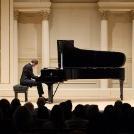I'm a bit late to the party, but I can never resist this conversation. I'll preface my opinions by saying that I have pop music on in the background as I'm writing this.
I would choose to listen to classical music over pop music 99% of the time. This is for a number of reasons, some of which have already been said.
I think that the melodies in tonal classical music are far more interesting than those in pop music. They are more creatively written, scaffolded by what I find to be far superior harmony and counterpoint. Listen to any Rachmaninoff piano prelude (23/4 and 23/10 are gems among gems for counterpoint) or just any short classical piece and it's plain that classical music accomplishes more in the same amount of time as a pop song's length. On the other end of length, when I've had this conversation (classical v. pop) with my friends, one of their biggest gripes is how long-winded classical music is. That a symphony can be longer than an hour long seems to be an utterly foreign idea--"Surely you get bored listening to anything for that long!" Actually, not really. I find that the tendency of classical music to be longer than pop music allows for so much more possibility and variety that a skilled composer can manipulate so well that I listen engaged for the entire hour-long symphony. Thematic development, something pop music lacks the time to execute thoroughly, is necessary to a good piece. But even where pop music could have some degree of thematic development, we still get to hear the same identical chorus three times. I recently discovered Liszt's Harmonies poetiques et religieuses. What he does with the melodic material of the Benediction de Dieu dans la solitude for 18 minutes is amazing. Each time the A theme returns, it's different. This is rarely the case in pop music.
I think the harmonies in classical music are more engaging than those in pop music. To say nothing of the typical four-chord progression, I find the other harmonic elements to be very boring. Someone said something about how a good songwriter must have a skilled grasp of voice-leading. While one would assume that to be the case, I find that in practice, there is little proper voice-leading in pop music. The harmony, it seems, nearly always consists of a whole bunch of parallel fifths. Disregarding voice-leading errors, this means that harmonic devices as simple as chord inversions are few and far between. Even Classical period harmony is more interesting than that.
Classical music is more performance-focused. This is kind of out there, but I wanted to give more reasoning than just pure musical content since that's what's been happening elsewhere in the thread. Have you ever listened to a good pop song and then googled it to find that the singer isn't a performer? Maybe that's something that just drives me crazy? Or if there is a performance, it seems that it's always performed in a key in a more comfortable range. I'm not talking about all of the pop musicians who tour and give live performances and want to make that clear. It seems that there are more and more pop musicians who only make studio recordings and rely on autotune and editing magic to make a good song. Can you imagine if Lugansky or Argerich or some orchestra used editing to fix the wrong notes in their recordings? Scandal would ensue. In the classical world, it's always been perform first, and then record second [if you are famous enough that people will actually listen to your recording, haha], and I think that standard helps ensure quality. In the pop world, it's the other way around and so anyone who wants to can make a simple pop record. I for one vastly prefer a live concert, whether classical or pop, to a recording.
I'll refrain from commenting more on this. I tried to avoid the elusive conclusion that pop or classical is better than the other and just discuss why I prefer classical music. Hopefully I was marginally successful.
Lastly, yes--I think it is ridiculous that people are criticizing that author for his passion for classical music. Besides acknowledging that people are entitled to their own opinions and that there is nothing remotely harmful about shouting from the rooftops about how much one likes classical music, it all just comes down to personal taste. I've been glorifying classical music, but I like pop and rock and all of the others too (just not as much, haha).



